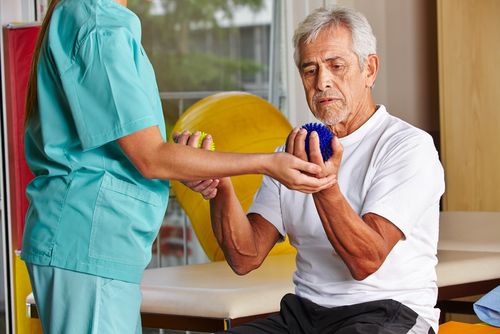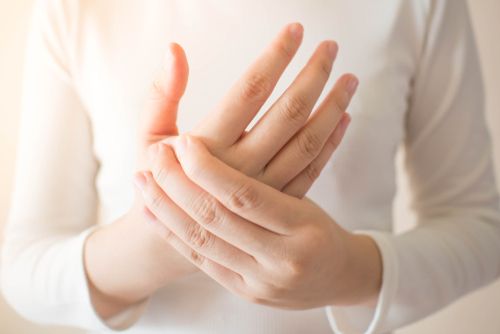 Written by Megan Smith, PT
Written by Megan Smith, PT
Hand therapy is the perfect way for people with pain, stiffness, or other fine motor challenges to improve mobility in the hand, fingers, thumb, and wrist.
Often, hand therapy is something prescribed by a medical professional following an injury, procedure, or illness, but it may also simply be begun at home by someone with a degenerative condition like arthritis who wants to stave off the pain and stiffness that come along with this type of illness.
Regardless of how it begins, hand therapy is a great tool for anyone who wants to improve or maintain the fine motor skills of their hands.
Whether for rehabilitation or preventative purposes, improving mobility in the thumb, fingers, hands, and wrist is a great practice to alleviate pain, either from conditions like arthritis and carpal tunnel, or to recover from an injury or illness.
Thankfully, due to the breadth of conditions that can be improved by the addition of hand therapy, the selection of tools available is equally diverse, allowing you to get exactly the movements and exercises that you need for your unique condition.
That being said, it might be challenging for you to find exactly what you’re looking for, or to know where to begin when starting therapy at home, even if you’re continuing therapy after leaving a hospital or stopping therapy at an outpatient clinic.
That’s why we’re here. We’ll recommend some of the best tips to make integrating hand therapy into your life completely effortless.

The most important part of embarking on a new journey or forming a new habit is to keep your reasons for doing this at the forefront of your mind.
Even if you have days when you’re tired, your hands are sore and the exercises hurt, or you just don’t want to do the exercises, remember why you wanted to do them to begin with.
Hand therapy is a way to improve your independence, improve your hand dexterity, decrease your pain, and help you live the life you want.
Regardless of your reasoning for beginning this therapy, keep that in mind even on your worst days and it will help you get through.
The following examples showcase many of the helpful hand therapy products offered by Rehabmart. The specifics of how they're used will help you to determine what devices and equipment are right for you, along with the guidance of your therapist.
When adding a new regimen or habit to your life, it’s important to mark your progress by trying to reach smaller, incremental goals instead of just setting a big goal and trying to make it there as soon as possible.
Setting smaller goals along the way helps reward your brain by giving you a sense of progress and accomplishment, reminding you that even if you haven’t made it to the finish line yet, you are improving and making your way there, slowly but surely.
Any time you’re dealing with pain, it’s important to really tune in to your body and be able to pick up on when things hurt because they’re sore versus when things hurt because you’re doing something wrong.
Whether you’re performing exercises under the guidance of a therapist or going at it alone, it’s of the utmost importance that you pay attention to how your body is feeling and speak up when something feels wrong.
Jumping off from the previous point, it’s important to make sure you’re performing the exercises that you need with the right form for maximum benefit and minimum damage.
The best way to make sure of this is to consult with a physical or occupational therapist. If you can’t do this, however, it’s a great idea to look up video tutorials or infographics with pictures of the proper form, so you can copy the movements and positioning.
A lot of people seem to repeat the statistic that it takes 21 days to form a new habit, but in reality, new studies are finding that the average is closer to 66 days, while different people can pick up or drop habits in as little as 18 days up to as long as 254 days, depending.
What does all this mean? Basically, it means that you shouldn’t expect change immediately, and that you need to stick with it in order to form a new habit and create a positive development in your life.
As important as it is to stick with it and keep trying, it’s also important to not get discouraged if you fall off the wagon. If you miss a day or a few days, you have not failed. All you have to do to redeem yourself is to keep trying.
If you don’t make the progress that you want in the timeframe that you wanted, it’s important to be gentle with yourself and look at all the things you have accomplished rather than those you have not. Focus on the positive changes you’re making for yourself and don’t give up.
Finally, one of the most important tips we can offer is to ask for help if you need it. Don’t feel like you have to go it alone.
If you need help with tasks while you get your hand strength or dexterity back, don’t feel ashamed. Depending on each other is part of what makes us human - no man is an island.
Whether you need help completing tasks around the house or you simply need a good support system to help you get through the bad days, make sure you ask for the help you need to get through.

Hand therapy is a great tool to help people improve joint health, pain level, and independence in performing a variety of tasks.
It can be used in rehabilitation or preventatively in order to help people recover from or improve a wide range of conditions, injuries, and illnesses.
Starting a new habit is always difficult, but continuing or beginning hand therapy at home is a great step towards a better life with less pain and more independence. And Rehabmart is here to help.
For more information on hand therapy, rehabilitation, and more helpful caregiving tips, check out our full selection of articles on Caregiver University.

Megan has been a part of Rehabmart since its inception nearly 20 years ago. For the past several years she has been enjoying her role as HR Director while maintaining her Physical Therapy license. When she isn't working on her next in-service or working to find a new team member, she enjoys her five children, helping those who have PT type ailments, baking, practicing yoga, and working out.